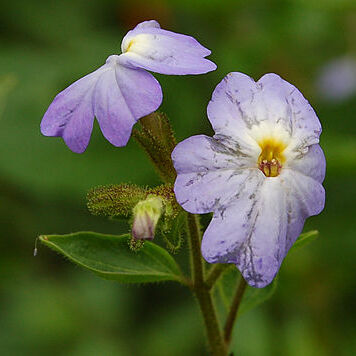Branched, unarmed herbs to 70 cm tall; stems terete, glabrous or pubescent, the hairs simple, sometimes glandular and viscid. Leaves ovate, to 6 cm long, the margins mostly entire; petioles slender, slightly winged, sometimes reduced; minor leaves present or not. Flowers solitary, axillary, the subtending leaves some-times reduced, the pedicels short but becoming longer in fruit, deciduous at the base; calyx tubular-campanulate with simple or glandular hairs, drying with prominent longitudinal veins, lobed less than /3 the way down, the lobes 4 or 5, This content downloaded from 192.104.39.2 on Tue, 14 May 2013 16:07:58 PMAll use subject to JSTOR Terms and Conditions1973] D'ARCY-FLORA OF PANAMA (Family 170. Solanaceae) 577 deltoid to lanceolate, sometimes rounded, becoming larger in fruit, exceeding but not enveloping the capsule, the tube sometimes inflated, strongly angled; co-rolla salverform, zygomorphic with a bulbous enlargement at the top of the green-ish tube, the limb large or small, the mouth very small; stamens 4, sometimes with a staminode or rarely a fifth fertile anther, didynamous, inserted just above and below the expansion in the corolla tube, the upper pair with flattened, curved, pilose filaments which close the mouth of the tube, their anthers each with one obsolete theca, the lower pair with basally geniculate filaments and smaller, 2-thecate anthers; the disc obsolete; ovary subsessile, glabrous or pubescent, 2-loculed, the ovules many on a large placenta, stigma elaborately expanded into a furrowed wafer compressed between the anthers, stigmatic on the distal rim. Fruit an erect 2-valved, coriaceous or chartaceous, many seeded, septicidally short-dehiscent capsule; seeds minute, prismatic, foveate; embryo straight or slightly curved, cotyledons ovate on a broad radicle. Chromosomes n 22, 44 (24).
More
Erect, branching herbs to 1 m, glabrous or pubescent with simple and glandular hairs. Leaves usually alternate, sometimes paired, simple, entire, petiolate. Flowers solitary, axillary, bisexual, zygomorphic. Calyx tubular, 4–5-lobed, the lobes triangular to |oblong. Corolla salver-shaped, white or blue; tube swollen at apex but contracted at mouth; limb 4–5–lobed, the lobes induplicate in bud. Stamens usually 4, inserted in upper part of corolla-tube, paired, a staminode or 5th stamen sometimes present; anthers anthers bilocular, not cohering, basifixed, dehiscing by longitudinal slits. Ovary bilocular; stigma expanded. Fruit a capsule, opening from apex, enclosed by calyx. Seeds prismatic.

